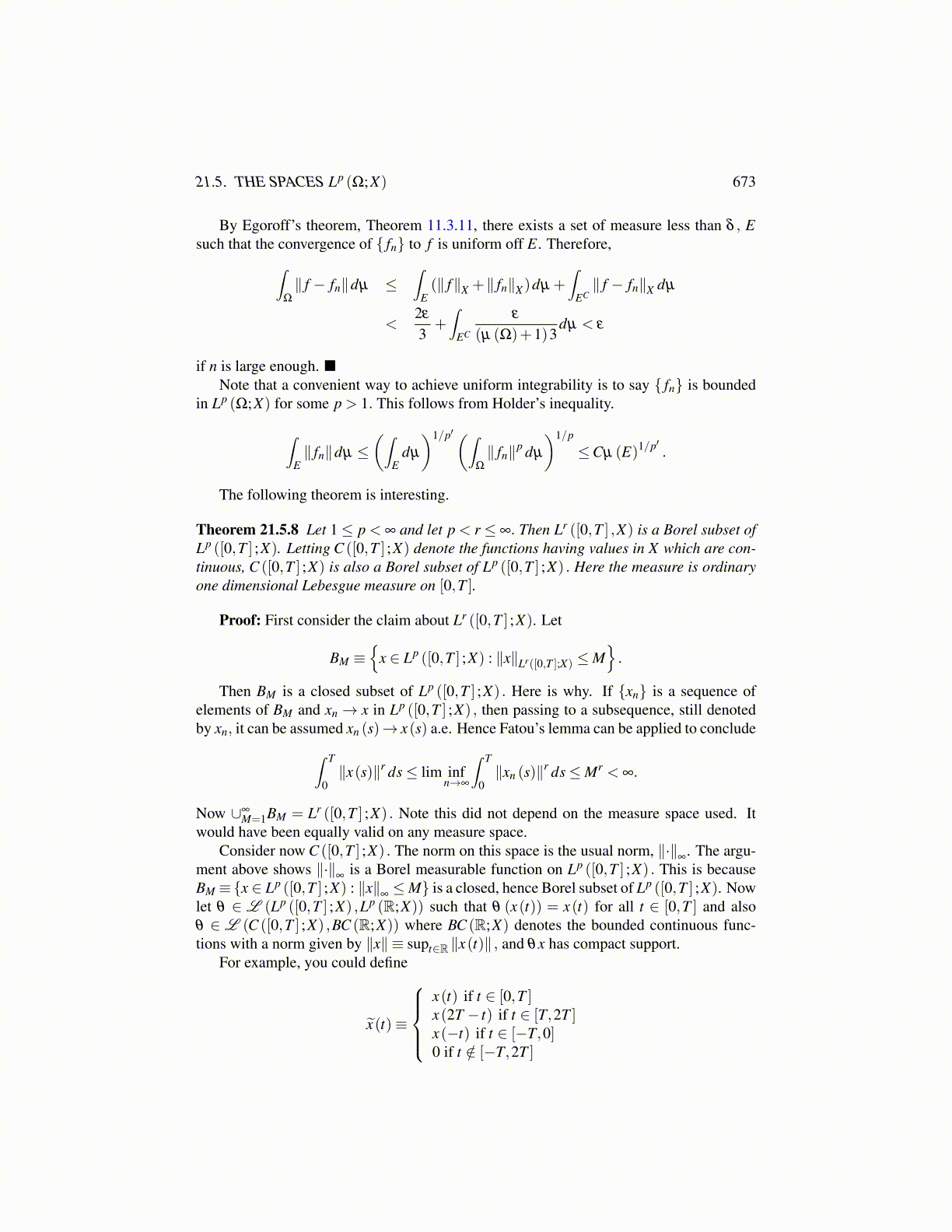
21.5. THE SPACES Lp (Ω;X) 673
By Egoroff’s theorem, Theorem 11.3.11, there exists a set of measure less than δ , Esuch that the convergence of { fn} to f is uniform off E. Therefore,∫
Ω
∥ f − fn∥dµ ≤∫
E(∥ f∥X +∥ fn∥X )dµ +
∫EC∥ f − fn∥X dµ
<2ε
3+∫
EC
ε
(µ (Ω)+1)3dµ < ε
if n is large enough.Note that a convenient way to achieve uniform integrability is to say { fn} is bounded
in Lp (Ω;X) for some p > 1. This follows from Holder’s inequality.
∫E∥ fn∥dµ ≤
(∫E
dµ
)1/p′(∫Ω
∥ fn∥p dµ
)1/p
≤Cµ (E)1/p′ .
The following theorem is interesting.
Theorem 21.5.8 Let 1≤ p < ∞ and let p < r ≤ ∞. Then Lr ([0,T ] ,X) is a Borel subset ofLp ([0,T ] ;X). Letting C ([0,T ] ;X) denote the functions having values in X which are con-tinuous, C ([0,T ] ;X) is also a Borel subset of Lp ([0,T ] ;X) . Here the measure is ordinaryone dimensional Lebesgue measure on [0,T ].
Proof: First consider the claim about Lr ([0,T ] ;X). Let
BM ≡{
x ∈ Lp ([0,T ] ;X) : ∥x∥Lr([0,T ];X) ≤M}.
Then BM is a closed subset of Lp ([0,T ] ;X) . Here is why. If {xn} is a sequence ofelements of BM and xn → x in Lp ([0,T ] ;X) , then passing to a subsequence, still denotedby xn, it can be assumed xn (s)→ x(s) a.e. Hence Fatou’s lemma can be applied to conclude∫ T
0∥x(s)∥r ds≤ lim inf
n→∞
∫ T
0∥xn (s)∥r ds≤Mr < ∞.
Now ∪∞M=1BM = Lr ([0,T ] ;X) . Note this did not depend on the measure space used. It
would have been equally valid on any measure space.Consider now C ([0,T ] ;X) . The norm on this space is the usual norm, ∥·∥
∞. The argu-
ment above shows ∥·∥∞
is a Borel measurable function on Lp ([0,T ] ;X) . This is becauseBM ≡{x ∈ Lp ([0,T ] ;X) : ∥x∥
∞≤M} is a closed, hence Borel subset of Lp ([0,T ] ;X). Now
let θ ∈ L (Lp ([0,T ] ;X) ,Lp (R;X)) such that θ (x(t)) = x(t) for all t ∈ [0,T ] and alsoθ ∈ L (C ([0,T ] ;X) ,BC (R;X)) where BC (R;X) denotes the bounded continuous func-tions with a norm given by ∥x∥ ≡ supt∈R ∥x(t)∥ , and θx has compact support.
For example, you could define
x̃(t)≡
x(t) if t ∈ [0,T ]x(2T − t) if t ∈ [T,2T ]x(−t) if t ∈ [−T,0]0 if t /∈ [−T,2T ]